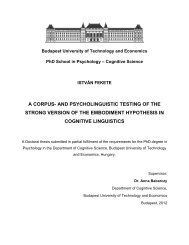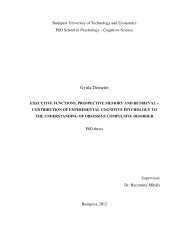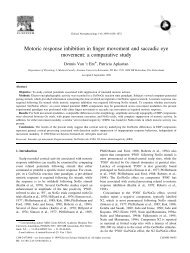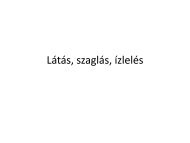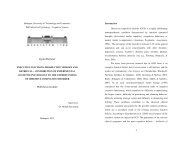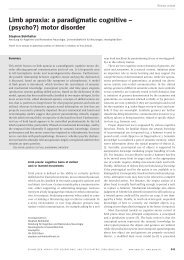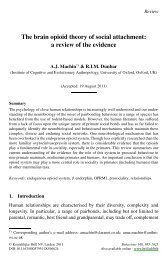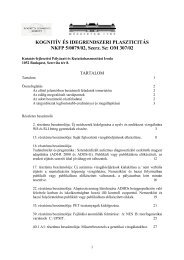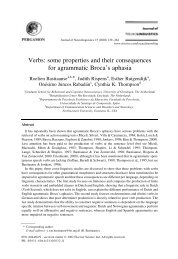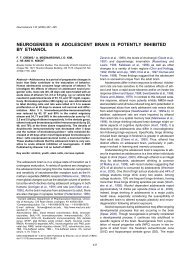Herlitz, Rehnman (2008)
Herlitz, Rehnman (2008)
Herlitz, Rehnman (2008)
Create successful ePaper yourself
Turn your PDF publications into a flip-book with our unique Google optimized e-Paper software.
Sex Differences in Episodic<br />
Memory<br />
Agneta <strong>Herlitz</strong> 1 and Jenny <strong>Rehnman</strong> 1,2<br />
1 Aging Research Center, Karolinska Institutet, Stockholm, Sweden, and 2 Stockholm University, Stockholm, Sweden<br />
ABSTRACT—Research shows sex differences in episodic<br />
memory. These differences vary in magnitude as a function<br />
of the type of material to be remembered. Throughout the<br />
life span, verbal episodic-memory tasks yield differences<br />
favoring women. In contrast, episodic-memory tasks requiring<br />
visuospatial processing result in differences favoring<br />
men. There are also sex differences favoring women<br />
on episodic-memory tasks requiring both verbal and visuospatial<br />
processing and on face-recognition tasks. Thus,<br />
there may be a small, general episodic-memory advantage<br />
for women—an advantage that can increase by the advantage<br />
women have over men in verbal production and<br />
can be reversed by the male advantage in visuospatial<br />
tasks. In addition, environmental factors affect the magnitude<br />
of the sex differences in episodic memory.<br />
KEYWORDS—sex differences; episodic memory; visuospatial;<br />
verbal<br />
Being able to remember events from one’s past is essential for<br />
functioning in society. By now, it is well known that a number of<br />
factors, among them age and education, affect one’s ability to<br />
remember. Whether one’s sex also influences the ability to remember<br />
everyday events is less well researched. One reason<br />
may be that, in the first comprehensive review of this subject,<br />
Maccoby and Jacklin (1974) did not find sex differences in<br />
memory. However, the theoretical model of memory used by<br />
those researchers was different from that of current theories,<br />
which may explain why they did not find sex differences.<br />
EPISODIC MEMORY<br />
Although several theories of memory exist today, most investigators<br />
would agree that memory can be subdivided into two<br />
broad categories: working memory (or short-term memory) and<br />
long-term memory. Long-term memory can in turn be divided<br />
Address correspondence to Agneta <strong>Herlitz</strong>, Aging Research Center,<br />
Karolinska Institutet, Gävlegatan 16, S-113 30 Stockholm, Sweden;<br />
e-mail: agneta.herlitz@ki.se.<br />
CURRENT DIRECTIONS IN PSYCHOLOGICAL SCIENCE<br />
into subsystems, one being episodic memory. Episodic memory<br />
refers to the conscious recollection of unique personal experiences<br />
in terms of their content (what), location (where), and<br />
temporal occurrence (when; Tulving, 2001). Episodic memory<br />
is typically assessed by first presenting some information (e.g.,<br />
episodes, words, objects, or faces), and by then asking the person<br />
to recall or recognize the earlier-presented information.<br />
What Impact Does Task Material Have on Sex Differences<br />
in Episodic Memory?<br />
Although Maccoby and Jacklin (1974) did not find sex differences<br />
in memory, many more recent studies have found sex<br />
differences favoring women in episodic-memory tasks. For example,<br />
in a large population-based study of 1,000 adults between<br />
35 and 80, we found sex differences on episodic-memory<br />
tasks in which the participants were told to try to remember lists<br />
of words, objects, or activities that had been presented earlier<br />
(<strong>Herlitz</strong>, Nilsson, & Bäckman, 1997). The difference between<br />
men and women on a word-recall task was d 5 .25 (see Fig. 1).<br />
d is computed by calculating the difference between the means<br />
of women and men, divided by the pooled standard deviation.<br />
Here, a positive value indicates that women perform at a higher<br />
level than men, and a negative value indicates that men outperform<br />
women. The closer the value is to zero, the smaller the<br />
difference. A d of .20 indicates that 59% of all women perform at<br />
a higher level than the average man. The comparable numbers<br />
for d 5 .40 and d 5 .60 are 66% and 73%, respectively. Notably,<br />
most tests used to assess episodic memory in clinical situations,<br />
such as the California Verbal Learning Test and subtests of the<br />
Wechsler Memory Scale, use similar materials as we did—that<br />
is, word lists, lists of objects, or pictures of objects. Women are<br />
typically found to perform at a higher level than men on these<br />
tests (e.g., Kramer, Delis, Kaplan, O’Donnell, & Prifitera, 1997).<br />
Maccoby and Jacklin (1974) noted that girls excel on verbal<br />
tasks and that boys perform at a higher level than girls on visuospatial<br />
tasks. Sex differences in verbal and visuospatial tasks<br />
have since then been confirmed in numerous studies (e.g., Hyde<br />
& Linn, 1988; Voyer, Voyer, & Bryden, 1995). Because women<br />
excel on verbal-production tasks—for example, tasks requiring<br />
52 Downloaded Copyright from<br />
cdp.sagepub.com r <strong>2008</strong> Association by Attila Keresztes for Psychological on February Science 25, 2013<br />
Volume 17—Number 1



